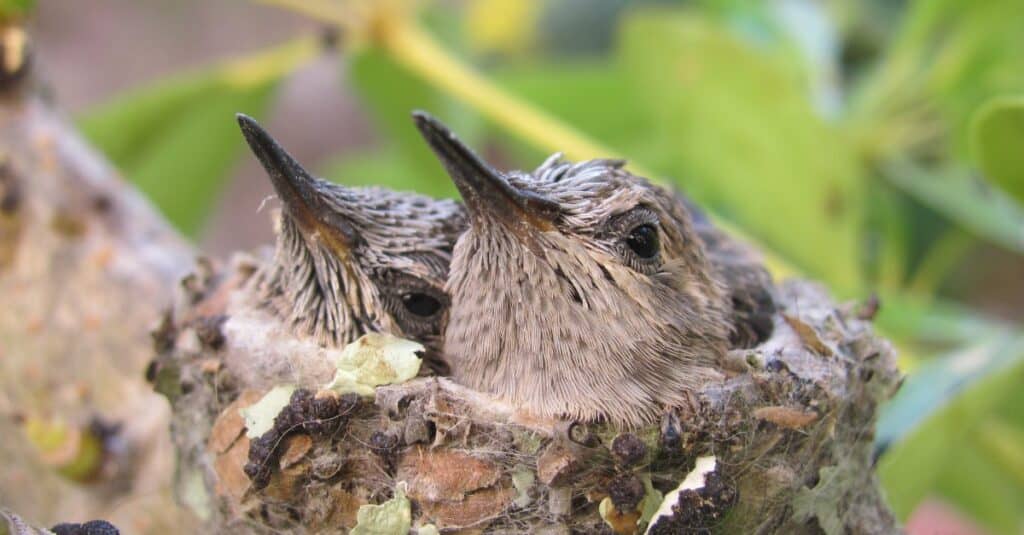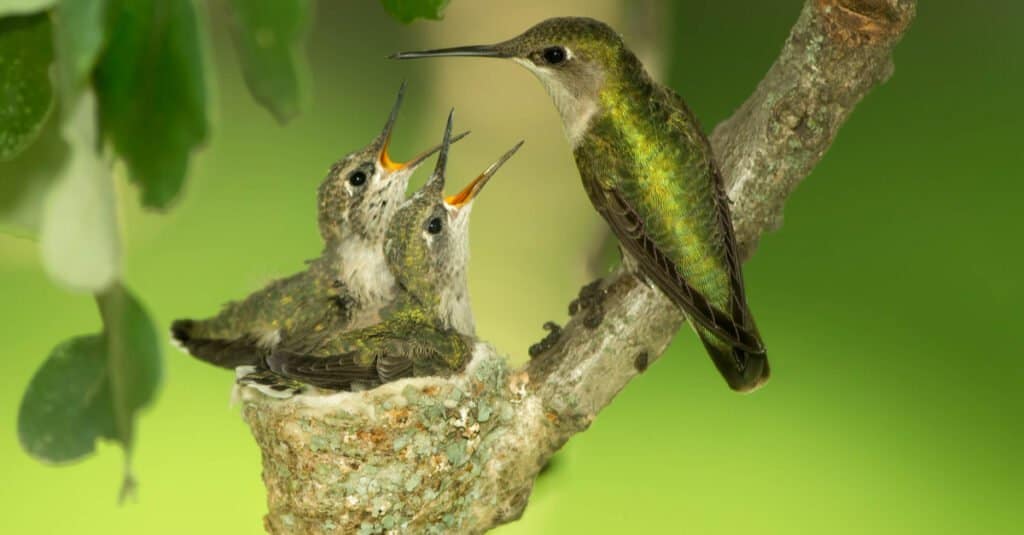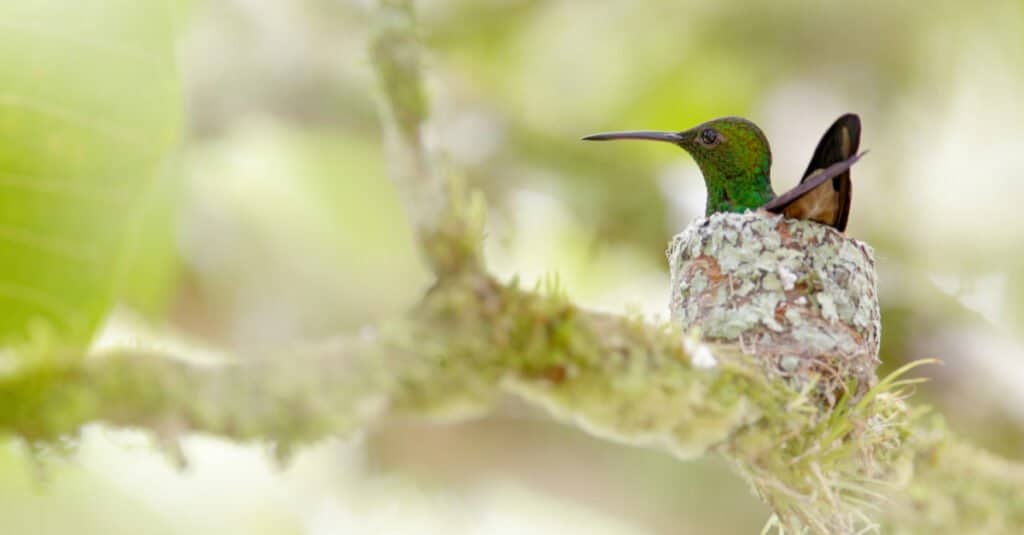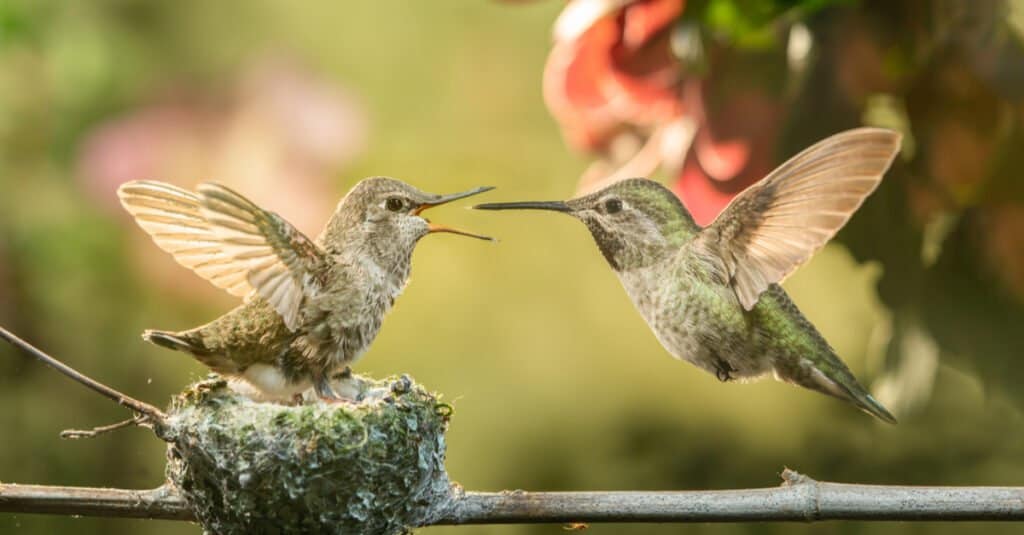It’s no secret that baby hummingbird chicks are seriously tiny. In fact, one type of hummingbird holds the record for the smallest on the planet. However, even though these birds are small, there is no shortage of astounding facts about them. Did you know that adult hummingbirds build stretchy nests, for example?
Keep reading to learn what baby hummingbirds are called and four more astounding facts about them!
#1: A Baby Hummingbird Has Many Names!

Hummingbird newborns are called chicks, hatchlings, or even nestlings!
©iStock.com/seeladyjane
Baby hummingbirds are called chicks, hatchlings, or nestlings.
Did you know that the name of a young hummingbird depends on how old it is? It’s true! Newborn baby hummingbirds are called chicks, hatchlings, or nestlings. Once they grow old enough to venture out of their nests, though, they are called fledglings.
Baby hummingbird chicks aren’t the only animals that have many names for their young. Many other types of birds like baby chickens, baby robins, and even baby toucans share the same names! Even though these birds don’t look the same as hummingbirds, their names are just one example of the similarities they share.
#2: Hummingbird Chicks Won’t Poop in Their Nests

Hummingbird chicks arch their backs to poop from the sides of their nests.
©Agnieszka Bacal/Shutterstock.com
There’s no doubt that baby hummingbird chicks are small, defenseless, and seemingly unable to do anything independently. However, when it comes to fulfilling their urge to poop, baby hummingbirds have an interesting instinct: pooping outside of their nests.
From birth, hummingbird chicks know not to poop in their nests. You might be wondering, then, how these tiny birds eliminate waste when they don’t know how to fly. Surprisingly, hummingbird chicks don’t need to move more than a few inches to avoid pooping in their treetop homes. The process is simple: they arch their backs, stick their tails in the air, and poop from the side of the nest.
When hummingbirds eliminate waste, they release both pee and poop from the same opening. They can also release both at the same time. Researchers say that this ability helps keep them safe from their long list of predators. In other words, the less time they spend standing still, the safer they are.
#3: Baby Hummingbird Nests Can Stretch

Hummingbirds use spider silk to make their nests stretchy enough to grow with their babies.
©ukrit.wa/Shutterstock.com
Even though baby hummingbirds are born weighing a tiny .6 grams, they waste no time growing. In fact, it only takes them about a month to reach adult size. For adult female hummingbirds, protecting their young is a top priority. Consequently, it is best to avoid moving the babies into a larger nest as they grow older.
Luckily, hummingbirds have an ingenious solution for their problem: nests that stretch! That means the typical plant down, feathers, and twigs aren’t the only ingredients for a hummingbirds’ nest. In addition to these, cotton fibers and spider silk are among the most common. These additional materials allow baby hummingbird nests to stretch as the babies get older.
Hummingbird nest contents aren’t the only interesting thing about them. Like the bird, these nests are seriously tiny. On average, hummingbird nests usually only measure about 1.5 inches in diameter. That means that the opening in the middle is about the same size as a penny – now that’s tiny!
#4: The Bee Hummingbird is the Smallest Hummingbird Chick in the World!

The bee hummingbird is so tiny, it is often mistaken for an actual bee!
©Ondrej Prosicky/Shutterstock.com
The Bee Hummingbird, which lives exclusively in Cuba, is the tiniest hummingbird on Earth. These hummingbirds are so small that they’re often mistaken for actual bees. It’s no wonder this is true, too, since they weigh less than a dime!
These tiny hummingbirds create the smallest nests of all species. These nests are about the same size as a quarter. Luckily, female hummingbirds don’t need much space to lay their eggs, since each egg is only about the size of a coffee bean. When the baby hummingbird chicks are born, they are about an inch long and roughly the size of a large raisin.
Even though baby bee hummingbirds are tiny, they are surprisingly not the epitome of cute. As newborns, their bodies are wrinkly and black. They are born almost completely naked but grow feathers anywhere from seven to ten days after birth. They also double their weight about two days after they’re born.
It’s worth noting that on the other end of the spectrum, the largest hummingbird is the giant hummingbird. They can reach over 9 inches in length!
#5: Hummingbird Eggs All Hatch the Same Day

Female hummingbirds don’t start incubating their eggs until they are done laying them.
©Freebilly Photography/Shutterstock.com
Typically, mother hummingbirds lay between one and three eggs at a time, depending on their species. However, it takes a lot of energy for a female hummingbird to lay an egg. What’s more, is that hummingbirds only consume enough food to sustain their energy levels for one night. Consequently, it’s not abnormal for there to be one or two days between laying eggs.
Astoundingly, even though the eggs might be laid days apart, the baby hummingbird chicks all hatch on the same day. But how is this possible? The answer is simple: female hummingbirds don’t begin incubating their eggs until she is done laying them. This ensures that all the eggs get equal incubation time and are the same age as they go through their stages of development. It’s also another example of an amazing way that female hummingbirds protect their young!
The photo featured at the top of this post is © ukrit.wa/Shutterstock.com
FAQs (Frequently Asked Questions)
What is a baby hummingbird called?
A newborn baby hummingbird is called a chick, hatchling, or nestling. Once the baby is ready to leave the nest, it is called a fledgling. A group of baby hummingbird eggs is called a clutch and a group of chicks is called a brood.
How much do baby hummingbirds weigh?
Baby hummingbirds are some of the tiniest birds known to man, weighing about .60 grams, about the same weight as a single green pea.
What do baby hummingbirds eat?
Baby hummingbird chicks depend solely on their mothers for sustenance. They eat regurgitated insects and nectar from their mothers’ beaks until they are old enough to forage for food on their own.
Where do baby hummingbirds live?
Most hummingbird babies prefer to live in tropical climates, such as the ones in Colombia and Ecuador. However, many species of baby hummingbirds can be found elsewhere. For example, the Ruby-throated Hummingbird migrates to the Gulf Coast every March.
Thank you for reading! Have some feedback for us? Contact the AZ Animals editorial team.






